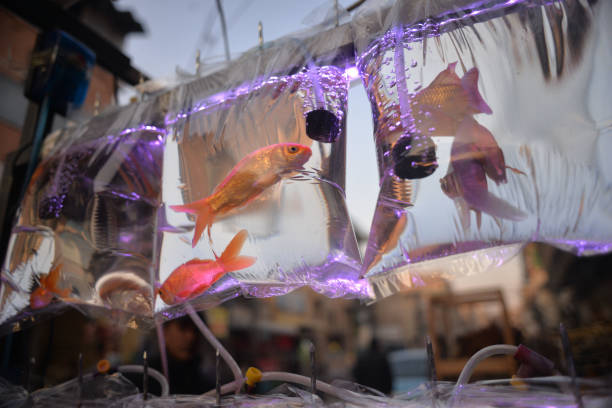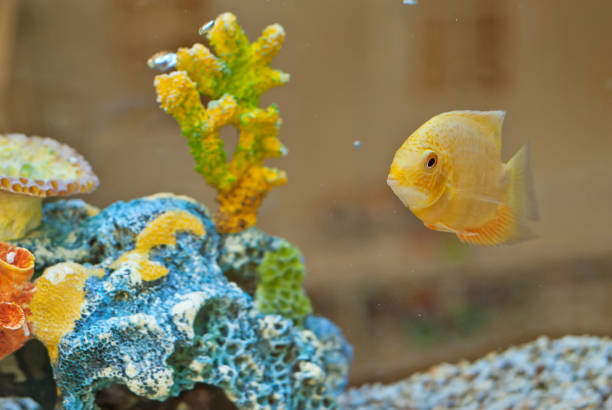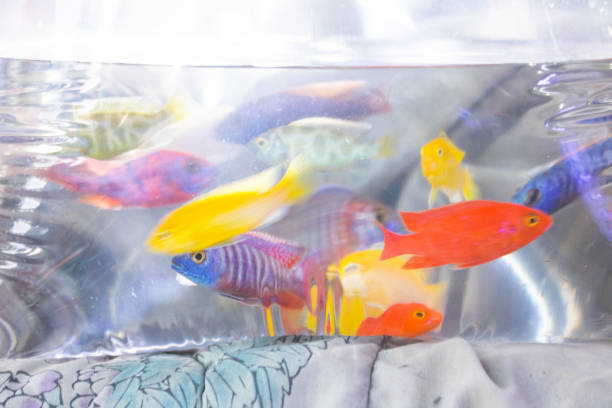Tips For Acclimating New Fish to the Tank
Introducing new fish to the tank is an important process that should be done very slowly. There are many things to consider like water temperature, oxygen levels, sound levels, nutrient content and even salinity.
The first thing that needs to be matched is the temperature. Most people simply float the bag in the tank to match temperatures but this is not enough.
1. Float the Bag in the Tank
Proper acclimating is not only important for fish but also for inverts, snails and plants. Adding a new fish to the aquarium causes the water to change in many ways. It changes the pH, temperature, nutrient levels, oxygen content, sound and other environmental conditions. This is why it is so important to acclimate the fish slowly to the tank.

The best way to do this is to float the bag in the tank. This will allow the water in the bag to become the same temperature as the tank. After the bag is at the same temperature as the tank open it up and remove most of the water from the bag. Then start to add the tank water to the bag a little bit at a time.
The goal is to have the bag about double in volume of the tank. This may take an hour or longer. When the bag is at this level of acclimating put the fish in the tank and do not feed it right away.
2. Drip Acclimation
It is one of the most heartbreaking experiences for aquarium hobbyists to bring home new fish only to have them die shortly afterwards. Often, it is due to shock-induced stress from the transit from the pet store to your home or a failure to properly acclimate them. There are other reasons such as bacterial infections (especially Aeromonas) or sudden power outages that affect electrical equipment but acclimating fish correctly and slowly reduces the risk of death.
The floating bag method only acclimates for water temperature but with freshwater fish and all saltwater animals, other parameters like pH, KH, GH, salinity, ammonia, and nitrate levels are important too. The Drip Acclimation method acclimates for all these factors at once, kind of hitting two birds with one stone.

Take the tank water from your aquarium, dump it into a clean bucket or container, place an air stone in the bucket and hook up a siphon with a gang valve or other type of adjustable air flow control in the middle to regulate the rate of drip. Start the siphon and set it to drip into the bucket at a low rate of no more than an hour. Check the tank and bucket water for the desired water parameters and once they match, stop the acclimation and transfer your fish to your main aquarium.
3. Slow Feeding
As you get familiar with your tank and its inhabitants you can start feeding them. When a new fish is added it’s best to introduce it to the tank slowly so you can monitor how it interacts with your other fish. It is also a good idea to feed it smaller foods (eg bloodworms) than your other fish can eat as this will get it used to eating in the presence of its tank companions. This is especially important for algae eaters like the tetras in the picture above. They are opportunistic and will snag a bit of anything that they can find.

Feeder blocks are not a good way to feed your fish if they are going to be away from home for long periods of time. You need adequate filtration and water movement for them to work, and you can’t be sure that your fish will actually consume the food. Live flakes and freeze-dried food are better choices.
If you want to “cycle” a new aquarium quickly using beneficial bacteria then add some of the gunk from an established tank or a little brown biomedia from a local fish store into the filter as well as adding plenty of aeration to the water (either a wavemaker creating choppy waves on the surface or multiple air stones). These will help to speed up the process.
4. Leave the Lights Off
Leaving the lights off while acclimating fish to the tank is important because it can help reduce stress levels. This is particularly true of saltwater fish that come from areas with much lower PAR values than a typical aquarium. This is because they can be severely impacted by bright light when they are first introduced to it. This can lead to them hiding out for hours, which can be harmful to their health.
Another reason why it is best to leave the lights off while acclimating a new fish to the tank is because it can help prevent territorial disputes with existing tank residents. This is especially important with territorial cichlids that are notorious for attacking any new fish that enter their territories.
If you do decide to use an acclimation container, be sure to choose one that is dark and has a lid. This will help to calm the fish and keep them from jumping out of it, which can be stressful for them. It’s also helpful to cover the acclimation container with a towel or other netting in order to ensure that it stays closed and does not get dirty or contaminated.
When it comes to acclimating new fish to the tank, it is always better to take your time. This will give your fish the best chance of surviving and thriving in their new home.

